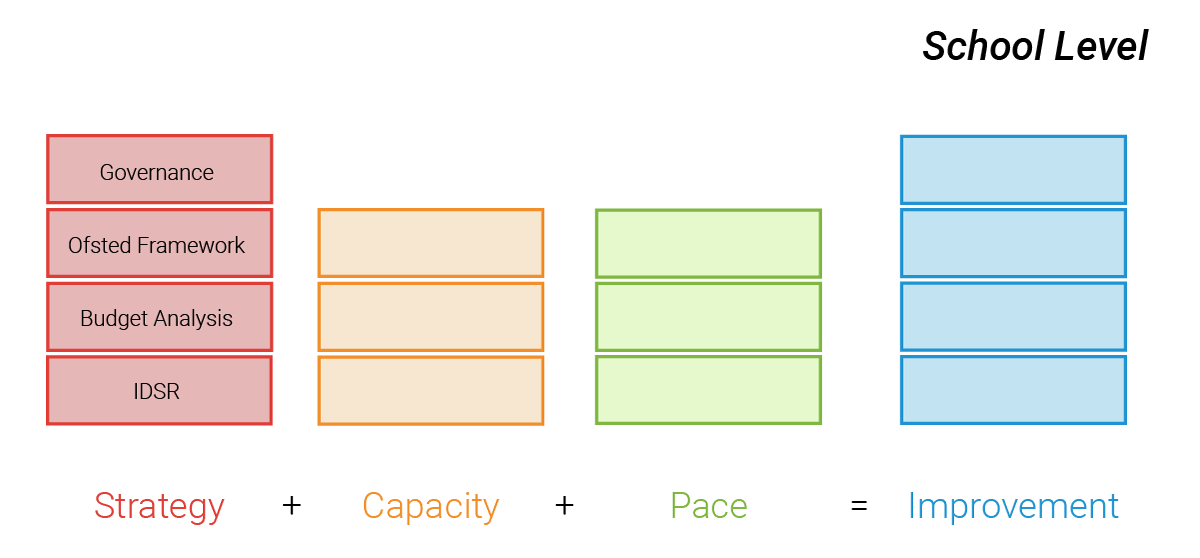In the last School Improvement blog, we highlighted that School Improvement is a broad concept and that there is not a one-size fits all solution. However, in recent years educationalists have started to identify the components that need to be in place to create positive impact. Sir David Carter, mentions in his book ‘Leading Academy Trusts’, that he believes that if a school can ensure they have explicitly and rigorously thought about the three key areas of Strategy, Capacity and Pace; they will ultimately lead the school in the right direction and improve standards.
About this Blog Series
Throughout this series of blogs, we will analyse each area and cover strategies to help schools move towards a more sustainable School Improvement programme. The humble MIS has a key role to play throughout the process. It provides information that feeds into strategy, assists in the implementation of processes and can measure impact. Each blog will focus on the different components in the formula, highlight the touch points with your MIS and provide best practice guidance. There is a lot to take in, but equally the information should provide comfort and support to the school improvement process.

Sir David Carter (2020), Leading Academy Trusts, John Catt
Strategy
Let’s begin with a focus on the Strategy element of the formula. Sir David Carter loosely explains the concept within his book ‘There needs to be a consistent strategy (or ‘plan’) for the way the school (or schools) will improve over time’. At School Level, we have four key areas that influence decision making and identification of standards:

IDSR
The latest government support mechanism to identify areas by which we can close the gap came in the form of the IDSR (Inspection Data Summary Report). The IDSR has been designed to assist schools with the analysis of the statutory data that has been provided to the Department for Education. It contains contextual information including workforce census data, financial data, Multi-Academy Trust (MAT), Local Authority information and school links.
The IDSR also provides year group contextual information, performance data, absence and exclusions and a breakdown of pupil destinations for the past 3 years. It provides information on past trends and analysis of whether the school is going in the correct direction. This data report is the only data that Ofsted analyses before entering a school. It is therefore crucial to all schools that they understand their demographic and can explain the level of performance to an inspector.
Budget Analysis
All schools must factor in that any type of improvement will come at a cost. A cost for the intent, implementation and regular ongoing support to ensure the intervention or development is a success and sustainable. It is important that as school leaders, we are aware of the costs and implications this will have on the school and ensure that the capacity of the learning is not hindered by any of these decisions.

Governance
Governors or trustees are responsible for the quality of teaching and learning within the school. Strong governance holds the school leaders to account to ensure the school is moving in the right direction. In turn this direction or accountability pressure felt by the leaders when explaining their actions will also lead to school improvement. Repetitive challenge and ambition to improve the standards of the pupils, will force leaders to provide a succinct strategy towards school improvement.
Ofsted Framework (EIF)
The Education Inspection Framework is designed to hold schools to account. It provides schools with four key areas of focus:
- Quality of Education
- Behaviour & Attitudes
- Personal Development
- Leadership and Management
The framework provides a breakdown of the areas in which schools are evaluated against. Auditing the school’s performance against these areas is a good starting strategy that will require research and development to raise standards. Here’s a summary of how Bromcom can support each area of the framework.

-
- INTENT – This area focuses on the curriculum and how it has been developed for its users. Although the MIS does not currently have a curriculum mapping function, it does allow staff to assess the different statements set across the key stages. It allows staff to identify and plan interventions to support the needs of some groups of children. A big part of school improvement is ensuring that the curriculum is accessible, identifying barriers to the learning and planning interventions.
-
- IMPLEMENTATION – This area focuses on the pedagogy of the classroom and centres on how the children are taught. Our MIS provides customisable assessment statements for teachers to work from to ensure that the children have the correct level taught to them. The statements include space to write comments about the performance to remind staff of the learning that has taken place. The lesson profile screen can be used to encourage staff to comment formatively about the lesson.
-
- IMPACT – This is about trying to measure or recognise the development of the children. Bromcom allows teachers to access assessments easily and this can influence planning and teaching moving forwards. The adaptable tracking sheets are fluid and easy to use. The integration of Power BI has been a game changer in recent years. Schools can thoroughly analyse their data, creating visual charts and infographics that allow staff to be able to visualise the data and trends, bringing it to life in a way that can help shape real impact. This level of analysis has changed the way that assessment should work within an MIS and the Trust level system, MAT Vision.
-
- BEHAVIOURS AND ATTITUDES – Student Behaviour can be heavily influenced by a school’s policy and their general approach. Having an MIS that allows you to implement and process the administrative elements of the policy is essential. A digital solution can provide a space to record information chronologically. This provides a great strength to contextualise behaviour and performance within the school and will assist teachers in the understanding of the performance and progress of a child or family. House points and behaviour points can be provided within a bespoke format for the school, pathways and workflows can be created to ensure an efficient response can be provided to the event. Visual representations can assist teachers to quickly notice patterns and trends in attitudes and behaviours. Transparency is key when providing support to the child, therefore having functionality that communicates with parents, the student and the teacher ensures a consistent approach.
-
- PERSONAL DEVELOPMENT – Development is focused on ensuring that the school provides support for the health and wellbeing of the children. Within Bromcom, an in-depth review of the needs of the child can be maintained on the child profile under the medical tab and any events of significance where the health of the child might have been affected can be captured and logged. For example, the safeguarding module can also be used to ensure that there is support in place for any abuse that the child may have experienced. The system also facilitates the use of user defined flags and user defined fields to allow the school or MAT to track their own specific requirements.
- LEADERSHIP AND MANAGEMENT – The MIS provides staff with a very clear way of identifying the trends in data provided by the class teacher. The ability to sort the data into different groups such as Pupil Premium, Free School Meals and any bespoke group the school has created allows for great ongoing tracking of particular groups. A real strength is that the system can go to a granular level and ensure that all children are picked up if they are not meeting the standard that they should be meeting. Filtering and sorting processes allow teachers and line managers to find the ‘underperforming’ children to provide specific interventions. It also allows the school to ensure that the support offered is equal for all children. This particularly helps with taking dinners whereby staff are able to provide the correct meal type to ensure financial support where needed.

How can an MIS Support School Improvement Strategy?
Utilising the tools and information available within your MIS can support your school to develop a strong strategy. At a basic level, an MIS can provide information for decision making, implement processes and then monitor outcomes. However, we aim to do much more than that, giving you the tools to bolster your strategy and create innovative working practices. We have touched on a fair few already, but here’s some more recent developments that have an impact on school strategy.
Built-in IDSR
Many schools use the IDSR to provide some targets for the teaching and learning within the school. The downside is that it is limited in terms of what data the report has access to, and how often it can be produced. So, we are developing a report with the same functions as the IDSR template, that can be used within every year group based on the summative assessment data that has been inputted.
This will provide schools with detailed feedback after every data drop, covering pupil performance and where the gaps are in their learning. A powerful resource that can be used to speed up School Improvement. Currently the Department for Education releases the official IDSR in November, however once Bromcom customers have the bespoke report in the system, schools will be able to create action plans from September to ensure no learning time is lost.
Integrated Finance
Finance is another area that schools need to understand before using their resources. They need to know they can afford the changes or developments before they begin the process. Bromcom has an integrated finance solution which allows schools to analyse the spend within their existing budgets as well as being able to have the opportunity to engage in the operational analysis of income and expenditure. Bromcom Finance can provide salary projections for budgeting purposes, and we are developing further predictive functionality. For example, the ability to forecast funding and income, income and expenditure, and outturn.
Real-time Governance
An MIS needs to ensure accountability is transparent and that key stakeholders are able to interpret the data that is being collected. The Bromcom system has been created to ensure that there is inclusivity of all members within the school community. Roles and permissions can be set to enable there to be parts of the system suitable for Governor / Trustee analysis. This means live headline figures for attendance, demographics, behaviour can all be viewed by the governors to ensure they are aware of the school performance and can review the standards by which the school has set. The transparency and accessibility allows there to be a thorough review of performance that can be done at any time, allowing the volunteer to be flexible with their interaction with the data. Bromcom has also spent time in developing reports that can highlight key information for stakeholders to ensure efficiency and effectiveness in their role supporting the school.

Conclusion
Strategy is one of the key components when looking at School Improvement. Bromcom can offer schools a toolkit that both supports its development and removes implementation barriers. The Bromcom MIS and Vision system provide data that offers routes of enquiry and provides clarification of school performance; that in turn can provide a focus for the leaders in improving the current standards.
However, Strategy is only one component of the School Improvement process. Whilst it is essential to have a plan in place, the implementation is just as important. The next blog will focus on ‘Capacity’, demonstrating how we can support its management and how this leads to sustainable solutions for School Improvement.
